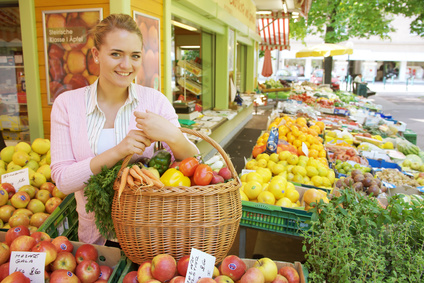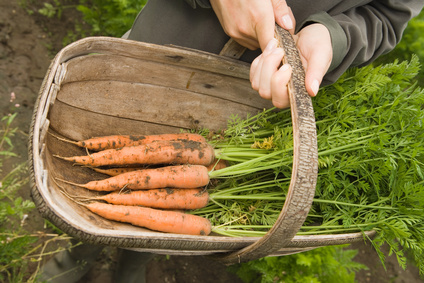Eat Organic - Buying and Growing Organic Food
Of all the choices we make that impact the health of our environment, none affect our individual health so personally and frequently as our choices in food. There is a great deal of information and misinformation out there regarding what's good for us and what's not, such as the highly controversial debate over GMO foods. Bottom line, if you want to ensure the health of your body and the health of your planet, eat organic, which by definition does not include GMOs.
- Look for the USDA Certified Organic Seal
- What Does it Mean to be Organic?
- What Does the Seal Really Mean?
- Refuse GMO Foods
- Grown Your Own Organic Food
- Go Vegetarian
Look For the USDA Certified Organic Seal
In 1990, the Organic Foods Production Act stipulated that the U.S. government must create rules and regulations regarding what qualifies as "organic" and what does not. The result is the National Organic Program run by a 15-member National Organic Standards Board, comprised of experts in fields that include farmers/growers, handlers/processors, retailers, consumers/public interest groups, environmentalists, scientists, and USDA credited certifying agents. In addition to their expert advice, the USDA took into account state, private and foreign organic certification programs in the final determination of what should be USDA Certified Organic. Return to Top
What Does it Mean to be Organic?

Verbatim from the USDA description of its National Organics Program standards, to qualify as "USDA Certified Organic" a food must meet the following requirements:
- Organic crops are raised without using most conventional pesticides, petroleum-based fertilizers, or sewage sludge-based fertilizers.
- Animals raised on an organic operation must be fed organic feed and given access to the outdoors. They are given no antibiotics or growth hormones.
- The NOP regulations prohibit the use of genetic engineering, ionizing radiation, and sewage sludge in organic production and handling. As a general rule, all natural (non-synthetic) substances are allowed in organic production and all synthetic substances are prohibited.
As for enforcing these standards, the USDA requires applicants to submit a plan for evaluation that details their 1) practices and substances used in production, 2) recordkeeping system and 3) plans in place for how they are going to protect and prevent the mixing of organic with non-organic substances or products. Once approved, USDA Organic Certified producers are subject to on-site inspections to ensure compliance. Violations result in an $11,000 fine. Return to Top
What the Seal Means
Common sense says that if a product is labeled "organic", then all of the ingredients are organic. Not true! As it turns out, some products can be more organic others. Here's how to differentiate among the various organic labels:
- 100% Organic - This is the ideal, meaning every ingredient meets USDA Certified Organic standrads.
- Organic - Second best, meaning at least 95 percent of the ingredients are technically organic.
- Made With Organic Ingredients - To carry this label, the product need only contain 70 percent organic ingredients.
Any product that is less than 70 percent organic may only list the organic ingredients in the standard ingredients list. Return to Top
Refuse to Accept GMO Foods!
The same organization that requires such stringent standards for organic foods has absolutely no standards or labeling requirements whatsoever for genetically modified foods. In fact, the USDA has yet to conduct any tests of GMOs regarding their long-term impact on health. Instead, they are relying on tests conducted by the very companies that stand to benefit from the sale of GMO seeds (i.e., Monsanto).
Monsanto is the world's leading provider of GMO seeds. These seeds have been genetically modified so that they can live through the application of Monsanto's Roundup herbicide. Despite Monsanto claims that its GMO seeds are engineered so as to require less of this chemical, it is reported that farmers tend to use 2 to 5 times more chemical herbicides on GMOs than non-GMO farmers do.
Meanwhile, independent tests have revealed dangers associated with GMO foods that include:
- Insects immune to natural pesticides
- Harm to beneficial insects
- Damage to soil
- Transfer of GMO genes to non-GMO crops (i.e., contamination)
Plus, it remains to be seen what long-term health affects we could see from our overconsumption of GMO foods. Though the Food and Drug Administration does not regulate GMOs, internal documents prove that its scientists have expressed concern over GMOs as they may lead to allergies and new diseases. Scientists in other countries evidently agree, as the European Union, Australia, the Czech Republic, Hong Kong, Russia, Japan, South Korea and Japan all require GMO foods be labeled as such, while some countries have reportedly banned their use altogether.
What is especially disturbing about all of this is the prevalence of GMOs in our food supply. It is estimated that 60 to 70 percent of U.S. food is genetically modified, making us the world's leading consumer of GMO foods!
Of the following products grown in the U.S., GMO seeds are used for:
- 91 percent of Soy
- 88 percent of Canola
- 85 percent of Corn
If you study your ingredients lists, then you know how many of our products contain soy and corn especially. Again, foods labeled 100% Organic are prohibited from containing any genetically modified ingredients. So to be on the safe side, go 100% organic when you can. Return to Top
Grow Your Own Food

Whether it's a few small containers on your patio or a big plot in your backyard, you can and should grow as much of your produce as possible. It's simply a matter of making organic choices every step of the way, including:
- Organic soil. Raised garden beds or containers are best, filled with organic soil purchased at your local garden store.
- Organic seeds. Instead of buying any old seeds that are probably hybrid GMOs, purchase organic seeds online through SeedsofChange.com.
- Organic fertilizer. Compost is best, which you can make yourself or buy at your local garden store.
- Organic pesticides. Buy ready-made organic pesticides or try your own at-home concoctions made from substances insects do not like. You may also introduce beneficial insects into your garden, like ladybugs which eat aphids.
Go Veg
Even if you do not cut meat and dairy completely from your diet, the green (and healthy) thing to do is to at least cut down, as the livestock industry is a major contributor to greenhouse gas emissions. In fact, providing you with just one pound of meat emits the same amount of greenhouse gases as driving an SUV 40 miles. Contrary to popular belief, a vegetarian or vegan diet done right can be healthier than a meat and dairy based diet. The Mayo Clinic is an excellent resource for learning more about how to ensure a veg diet may meet all of your nutritional requirements. Return to Top
